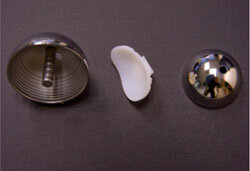Shoulder Resurfacing
Resurfacing Preserves
Most patients with end stage arthritis of the shoulder are treated by total shoulder replacement. This involves removal of the humeral head and insertion of a stem into the medullary space of the humerus. The results are usually quite satisfactory, however, there remain some concerns. Stem supported devices can cause a stress riser or stress shielding effect. This can lead to periprosthetic fracture or prosthetic loosening. Another concern is “pilot error” with insertion of a stemmed device. If the version of a shoulder device is incorrect by just 15° a painful shoulder will be the result.
Shoulder resurfacing is attractive because it preserves the humeral head. The retained humeral head continues to provide proprioceptive feedback. The resurfaced shoulder is stable and capable of an excellent range of motion. Since the humeral head is retained it is easier to assure correct version, offset and inclination of the prosthesis during surgery. With a limited amount of implanted material, infection if it occurs can be dealt with more easily. Because the humerus is not decapitated, shoulder resurfacing is also a less invasive surgery. There is less pain and blood loss and an easier rehabilitation from resurfacing as compared to total shoulder replacement.
The Results
Most patients experienced little or no pain and only two experienced severe pain. Of the patients assessed for postsurgical activity, 39% participated in strenuous athletics or work and only two were dissatisfied with their function. 92% of patients were not limited in their activities.
Shoulder resurfacing in our patients achieved its goal of reducing pain, and increasing function. The satisfaction results in this study are as good as or better than those reported using a conventional stemmed humeral prosthesis. The survival of the resurfacing humeral prosthesis is very satisfactory but we found like other authors using total shoulder replacement prostheses that the glenoid component remains vulnerable to wear and loosening over time.

